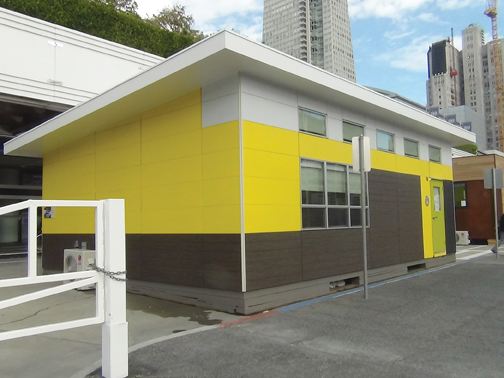At Greenbuild 2012, Building Design+Construction sponsored the fabrication of a modular, energy-efficient classroom, which was displayed outside the North Hall of the Moscone Center in San Francisco. BD+C talked to several people as they left the SAGE classroom to see what they thought and what caught their eye. Here’s what they had to say:
 Joy Bennett, Market Development Manager, Ashland Inc. (right) – “I think there were a lot of interesting products featured. There seemed to be a fair amount of space. I’m guessing it goes up pretty fast, which is a huge benefit, and that with all the windows and lighting that it’s a much better temporary solution than many of the things that have been used in the past.”
Joy Bennett, Market Development Manager, Ashland Inc. (right) – “I think there were a lot of interesting products featured. There seemed to be a fair amount of space. I’m guessing it goes up pretty fast, which is a huge benefit, and that with all the windows and lighting that it’s a much better temporary solution than many of the things that have been used in the past.”
Anthony Garrison, Installed Business Consultant, Ashland Inc. (left) – “I could see it being used in a place like Haiti where they want to bring normalcy back to the children. Obviously you want to put them back in a situation where they’re more familiar. Something like this could be shipped in and would go up pretty quick. The insulation was pretty amazing; I’ve never seen anything like that. It’s nothing like the classrooms I was used to.”
 Amelia Feichtner, Principal, Cuningham Group Architecture Inc. – “One of the major takeaways for me was the amount of natural daylight they got into the space, and not just with the windows but also the controllability of them. What we face a lot is that we get all this natural daylight in, but if you need a blackout situation to do presentations or something, it gets difficult. So that was definitely something that left an impression. Overall, as someone who’s looked into this for a while, it was a really beautiful space.”
Amelia Feichtner, Principal, Cuningham Group Architecture Inc. – “One of the major takeaways for me was the amount of natural daylight they got into the space, and not just with the windows but also the controllability of them. What we face a lot is that we get all this natural daylight in, but if you need a blackout situation to do presentations or something, it gets difficult. So that was definitely something that left an impression. Overall, as someone who’s looked into this for a while, it was a really beautiful space.”
 Francis Gichuhi, Habitech Consultants, Nairobi, Kenya – “This project offered a lot of interesting insights that I will consider for a similar project that I will be working on in Kenya. I hope this will lead to more contacts and greater information on the subject.”
Francis Gichuhi, Habitech Consultants, Nairobi, Kenya – “This project offered a lot of interesting insights that I will consider for a similar project that I will be working on in Kenya. I hope this will lead to more contacts and greater information on the subject.”
 Annie Argento, Assoc. Principal, Gaia Development – “The modular classroom is very inviting and just the kind of space one wants for a child to learn and grow. The natural daylight penetration, healthy and vibrant materials, and the obvious adaptability are all best practices for healthy schools, and it’s wonderful to see these principles and strategies come to fruition in a structure like this.” +
Annie Argento, Assoc. Principal, Gaia Development – “The modular classroom is very inviting and just the kind of space one wants for a child to learn and grow. The natural daylight penetration, healthy and vibrant materials, and the obvious adaptability are all best practices for healthy schools, and it’s wonderful to see these principles and strategies come to fruition in a structure like this.” +
Related Stories
| Aug 11, 2010
Great Solutions: Healthcare
11. Operating Room-Integrated MRI will Help Neurosurgeons Get it Right the First Time A major limitation of traditional brain cancer surgery is the lack of scanning capability in the operating room. Neurosurgeons do their best to visually identify and remove the cancerous tissue, but only an MRI scan will confirm if the operation was a complete success or not.
| Aug 11, 2010
Great Solutions: Collaboration
9. HOK Takes Videoconferencing to A New Level with its Advanced Collaboration Rooms To help foster collaboration among its 2,212 employees while cutting travel time, expenses, and carbon emissions traveling between its 24 office locations, HOK is fitting out its major offices with prototype videoconferencing rooms that are like no other in the U.
| Aug 11, 2010
2009 Judging Panel
A Matthew H. Johnson, PE Associate Principal Simpson Gumpertz & HegerWaltham, Mass. B K. Nam Shiu, SE, PEVP Walker Restoration Consultants Elgin, Ill. C David P. Callan, PE, CEM, LEED APSVPEnvironmental Systems DesignChicago D Ken Osmun, PA, DBIA, LEED AP Group President, ConstructionWight & Company Darien, Ill.
| Aug 11, 2010
Inspiring Offices: Office Design That Drives Creativity
Office design has always been linked to productivity—how many workers can be reasonably squeezed into a given space—but why isn’t it more frequently linked to creativity? “In general, I don’t think enough people link the design of space to business outcome,” says Janice Linster, partner with the Minneapolis design firm Studio Hive.
| Aug 11, 2010
BIM school, green school: California's newest high-performance school
Nestled deep in the Napa Valley, the city of American Canyon is one of a number of new communities in Northern California that have experienced tremendous growth in the last five years. Located 42 miles northeast of San Francisco, American Canyon had a population of just over 9,000 in 2000; by 2008, that figure stood at 15,276, with 28% of the population under age 18.







